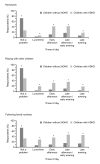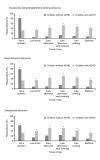Impact of attention-deficit/hyperactivity disorder on the patient and family: results from a European survey
- PMID: 18957105
- PMCID: PMC2588557
- DOI: 10.1186/1753-2000-2-31
Impact of attention-deficit/hyperactivity disorder on the patient and family: results from a European survey
Abstract
Background: Children with attention-deficit/hyperactivity disorder (ADHD) often experience problems with education, interaction with others and emotional disturbances. Families of ADHD children also suffer a significant burden, in terms of strain on relationships and reduced work productivity. This parent survey assessed daily life for children with ADHD and their families.
Method: This pan-European survey involved the completion of an on-line questionnaire by parents of children (6-18 years) with ADHD (ADHD sample) and without ADHD (normative population sample). Parents were questioned about the impact of their child's ADHD on everyday activities, general behaviour and family relationships.
Results: The ADHD sample comprised 910 parents and the normative population sample 995 parents. 62% of ADHD children were not currently receiving medication; 15% were receiving 6-8 hour stimulant medication and 23% 12-hour stimulant medication. Compared with the normative population sample, parents reported that ADHD children consistently displayed more demanding, noisy, disruptive, disorganised and impulsive behaviour. Significantly more parents reported that ADHD children experienced challenges throughout the day, from morning until bedtime, compared with the normative population sample. Parents reported that children with ADHD receiving 12-hour stimulant medication experienced fewer challenges during early afternoon and late afternoon/early evening than children receiving 6-8 hour stimulant medication; by late evening and bedtime however, this difference was not apparent. ADHD was reported to impact most significantly on activities such as homework, family routines and playing with other children. All relationships between ADHD children and others were also negatively affected, especially those between parent and child (72% of respondents). Parents reported that more children with ADHD experienced a personal injury in the preceding 12 months, including those requiring the attention of healthcare professionals. Although 68% of parents were satisfied with their child's current treatment, 35-40% stated that their child's ADHD symptoms needed to be more effectively treated during the afternoon and evening.
Conclusion: This parent survey highlights the breadth of problems experienced by ADHD children and the impact throughout the day on both activities and relationships. Therefore, there is a need for treatment approaches that take into account the 24-hour impact of the disorder and include all-day coverage with effective medication.
Figures






References
-
- Stein MA, Szumowski E, Blondis TA, Roizen NJ. Adaptive skills dysfunction in ADD and ADHD children. J Child Psychol Psychiatry. 1995;36:663–670. - PubMed
-
- Biederman J, Faraone SV, Spencer T, Wilens T, Norman D, Lapey KA, Mick E, Lehman BK, Doyle A. Patterns of psychiatric comorbidity, cognition, and psychosocial functioning in adults with attention deficit hyperactivity disorder. Am J Psychiatry. 1993;150:1792–1798. - PubMed
LinkOut - more resources
Full Text Sources

